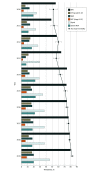Mortality and Morbidity of Infants Born Extremely Preterm at Tertiary Medical Centers in China From 2010 to 2019
- PMID: 33974055
- PMCID: PMC8114138
- DOI: 10.1001/jamanetworkopen.2021.9382
Mortality and Morbidity of Infants Born Extremely Preterm at Tertiary Medical Centers in China From 2010 to 2019
Abstract
Importance: Extreme prematurity is associated with a substantial burden on health care systems worldwide. However, little is known about the prognosis of infants born extremely preterm in developing countries, such as China.
Objective: To describe survival and major morbidity among infants born extremely preterm in China over the past decade.
Design, setting, and participants: This retrospective cohort study was conducted from January 1, 2010, through December 31, 2019. Included individuals were infants with gestational age less than 28 weeks discharged from 1 of 68 neonatal intensive care units located in 31 provinces in China. Data were analyzed from August through October 2020.
Exposure: Extremely preterm birth.
Main outcomes and measures: Survival to discharge and major morbidity (ie, bronchopulmonary dysplasia, grades III-IV intraventricular hemorrhage, white matter injury, stage II-III necrotizing enterocolitis, sepsis, or severe retinopathy of prematurity) were measured.
Results: Among 8514 eligible infants, 5295 (62.2%) were male and 116 infants (2.0%) were small for gestational age (SGA). Overall, 5302 infants (62.3%) survived to discharge. The survival rate was 1 of 21 infants (4.8%) at 22 weeks, 13 of 71 infants (18.3%) at 23 weeks, 144 of 408 infants (35.3%) at 24 weeks, 480 of 987 infants (48.6%) at 25 weeks, 1423 of 2331 infants (61.0%) at 26 weeks, and 3241 of 4692 infants (69.1%) at 27 weeks. Survival increased from 136 of 241 infants (56.4%; 95% CI, 50.1%-62.7%) in 2010 to 1110 of 1633 infants (68.0%; 95% CI, 65.7%-70.2%) in 2019 for infants born at 24 to 27 weeks (mean difference, 11.5%; 95% CI, 4.9%-18.2%; P < .001), without a significant change for infants born at less than 24 weeks. Major morbidity was found in 5999 of 8281 infants overall, for a rate of 72.4%, which increased from 116 of 223 infants (52.0%; 95% CI, 45.4%-58.6%) to 1363 of 1656 infants (82.3%; 95% CI, 80.5%-84.1%) from 2010 to 2019 (mean difference, 30.3%; 95% CI, 23.5%-37.1%, P < .001). Regional variations in survival were identified, with an almost 2-fold increase (1.94-fold; 95% CI, 1.66-2.27; P < .001) from 188 of 474 infants (39.7%) in northwest China to 887 of 1153 infants (76.9%) in north China. Gestational age (adjusted risk ratio [aRR], 1.084; 95% CI, 1.063-1.105; P < .001), birth weight (aRR, 1.028; 95% CI, 1.020-1.036; P < .001), premature rupture of membranes (aRR, 1.025; 95% CI, 1.002-1.048; P = .03), and antenatal steroids (aRR, 1.029; 95% CI, 1.004-1.055; P = .02) were associated with improved survival, while being born SGA (aRR, 0.801; 95% CI, 0.679-0.945; P = .01), being male (aRR, 0.975; 95% CI, 0.954-0.997; P = .02), multiple birth (aRR, 0.955; 95% CI, 0.929-0.982; P = .001), having a mother with gestational diabetes (aRR, 0.946; 95% CI, 0.913-0.981; P = .002), and low Apgar score (aRR, 0.951; 95% CI, 0.925-0.977; P < .001) were found to be risk factors associated with decreased chances of survival.
Conclusions and relevance: This study found that infants born extremely preterm were at increased risk of mortality and morbidity in China, with a survival rate that improved over time and a major morbidity rate that increased. These findings suggest that more active and effective treatment strategies are needed, especially for infants born at gestational age 25 to 27 weeks.
Conflict of interest statement
Figures


Comment in
-
The Importance of Harmonized Databases for Infants Born Extremely Preterm-If You Are Not Counted, You Are Not Accounted.JAMA Netw Open. 2021 May 3;4(5):e219709. doi: 10.1001/jamanetworkopen.2021.9709. JAMA Netw Open. 2021. PMID: 33974059 No abstract available.
References
-
- Schmidt B, Asztalos EV, Roberts RS, Robertson CM, Sauve RS, Whitfield MF; Trial of Indomethacin Prophylaxis in Preterms (TIPP) Investigators . Impact of bronchopulmonary dysplasia, brain injury, and severe retinopathy on the outcome of extremely low-birth-weight infants at 18 months: results from the trial of indomethacin prophylaxis in preterms. JAMA. 2003;289(9):1124-1129. doi:10.1001/jama.289.9.1124 - DOI - PubMed
Publication types
MeSH terms
LinkOut - more resources
Full Text Sources
Other Literature Sources
Medical
Miscellaneous

